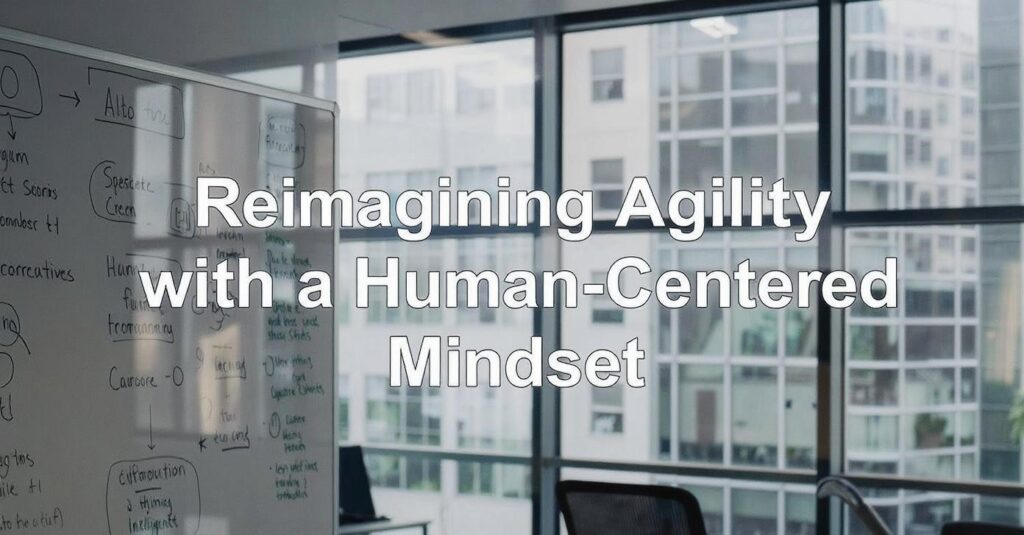In today’s rapidly evolving business environment, organizations are under intense pressure to adapt, innovate, and remain competitive. Agility has become the defining characteristic of successful enterprises. But workplace agility is not merely a function of digital tools or streamlined workflows—it is rooted in the foundation of a Human-Centered Culture. At the heart of adaptability lies empathy, collaboration, and a focus on the individual experience. That’s why workplace agility begins with human-centered culture.
Organizations that prioritize people, values, and inclusive systems are more capable of embracing change, fostering innovation, and creating long-term value. This shift is being acknowledged and embraced by forward-thinking businesses like Company name, who understand that resilience and flexibility come from within their people first.
Defining Workplace Agility
Workplace agility refers to an organization’s ability to rapidly adapt to changes in the market, industry, or internal operations. It encompasses the flexibility to pivot strategies, deploy new technologies, reconfigure teams, and respond to evolving customer expectations. However, agility is not only a structural or operational concern—it’s cultural.
A truly agile workplace is one where employees are empowered to make decisions, innovate freely, and collaborate across functions. These capabilities do not flourish in rigid hierarchies or bureaucratic systems. They thrive in a human-centered culture where individuals feel valued, heard, and supported.
What is Human-Centered Culture?
Human-centered culture is a workplace philosophy that places people at the core of all organizational activities. It emphasizes employee experience, psychological safety, diversity, empathy, and purpose. In such environments, employees are not seen as resources but as co-creators of value.
By fostering human-centered culture, organizations promote a sense of belonging and trust that drives engagement and performance. Employees in these environments are more willing to share ideas, voice concerns, take risks, and collaborate, which are the foundational behaviors of agile teams.
The Direct Link Between Culture and Agility
Culture sets the tone for how teams operate. A human-centered culture nurtures emotional intelligence, adaptability, and creativity—qualities essential for agile transformation. When people feel safe, supported, and connected to a larger purpose, they naturally align themselves with the organization’s mission and goals.
In contrast, a culture driven by fear, micromanagement, or excessive control inhibits responsiveness. Employees are less likely to take initiative or experiment with new ideas in such setups.
Organizations like Company name that focus on cultivating human-centered culture find it easier to navigate change, drive innovation, and achieve sustainable growth. (Read More)
Agile Transformation Starts with Leadership
Leadership plays a pivotal role in embedding a human-centered culture. Agile leaders are not just taskmasters—they are coaches, mentors, and visionaries who model empathy and trust. They focus on removing barriers, encouraging open communication, and supporting team autonomy.
Rather than dictating decisions, agile leaders collaborate with their teams, giving them ownership over outcomes. This sense of ownership is a powerful motivator and a key aspect of why workplace agility begins with human-centered culture.
When leaders demonstrate vulnerability, admit mistakes, and solicit feedback, they inspire others to do the same. This transparency builds trust, accelerates learning, and drives agility across the organization.
The Role of Psychological Safety in Agile Workplaces
Psychological safety is a key component of both human-centered cultures and agile workplaces. It refers to an environment where individuals feel comfortable taking risks, voicing their opinions, and admitting errors without fear of retaliation.
When employees know that their contributions are valued, they are more likely to experiment, iterate, and innovate. These behaviors are essential for agility, especially in industries facing continuous disruption.
Company name integrates this concept by promoting team rituals, feedback loops, and inclusive dialogue that create a psychologically safe environment. (Read More)
Diversity, Equity, and Inclusion: A Core Agility Driver
Diversity of thought fuels innovation. Inclusive workplaces where individuals from varied backgrounds feel welcomed and heard foster richer collaboration and more dynamic problem-solving. Agile teams benefit immensely from different perspectives, cultural experiences, and creative approaches.
Human-centered culture actively supports diversity, equity, and inclusion (DEI) not just as a compliance checkbox but as a strategic enabler of agility. By removing systemic barriers and ensuring equitable opportunities, organizations unlock the full potential of their workforce.
Agile transformation will fail in environments that marginalize voices or maintain status quo leadership. DEI must be baked into the cultural fabric, and not treated as a side initiative.
Employee Empowerment as a Pathway to Agility
Empowered employees drive agile outcomes. A human-centered approach encourages autonomy and initiative. Instead of waiting for top-down instructions, empowered employees are proactive, resourceful, and driven by purpose.
To cultivate such empowerment, organizations must invest in:
Skill development
Transparent communication
Decentralized decision-making
Purpose-driven leadership
Company name believes in creating agile talent ecosystems where individuals are supported with the right tools, mentorship, and learning opportunities to lead from wherever they stand. (Read More)
Feedback Loops and Continuous Learning
A key pillar of agile organizations is their ability to learn continuously. This learning doesn’t happen in isolation; it is embedded in culture through constant feedback loops. Human-centered culture promotes feedback not as criticism, but as a mechanism for growth.
Real-time feedback, cross-functional retrospectives, and transparent communication fuel faster iterations and improvements. These learning loops create responsive systems that can adjust course when needed—without excessive friction.
In human-centered cultures, failure is not feared but embraced as a learning opportunity, making agility a sustainable capability, not a one-time initiative.
Technology Alone Is Not the Answer
While digital tools and automation play a role in enhancing agility, they are not sufficient. Without a culture that values adaptability, tools become just another layer of complexity. Agile success lies not in deploying platforms, but in transforming mindsets.
Human-centered culture prepares the ground for effective tech adoption by encouraging experimentation, feedback, and learning. When employees are part of the decision-making process around new technologies, the implementation is smoother and more effective.
Agile companies like Company name recognize this balance. They focus on people first—technology second—to ensure tools are used in ways that truly enable flexibility and innovation. (Read More)
Agility in Hybrid and Remote Workplaces
The shift to hybrid and remote work models has redefined agility. Teams are now distributed, asynchronous, and diverse. In this context, human-centered culture becomes even more critical. Employees need to feel connected despite physical distances.
Agile remote workplaces prioritize communication clarity, digital collaboration, and emotional well-being. Managers are trained to lead with empathy, respect time zones, and support mental health.
Remote-first policies that center on trust, transparency, and flexibility are examples of how workplace agility begins with human-centered culture.
Read Full Article : https://bizinfopro.com/blogs/hr-blogs/why-workplace-agility-begins-with-human-centered-culture/
About Us : BizInfoPro is a modern business publication designed to inform, inspire, and empower decision-makers, entrepreneurs, and forward-thinking professionals. With a focus on practical insights and in‑depth analysis, it explores the evolving landscape of global business—covering emerging markets, industry innovations, strategic growth opportunities, and actionable content that supports smarter decision‑making.



